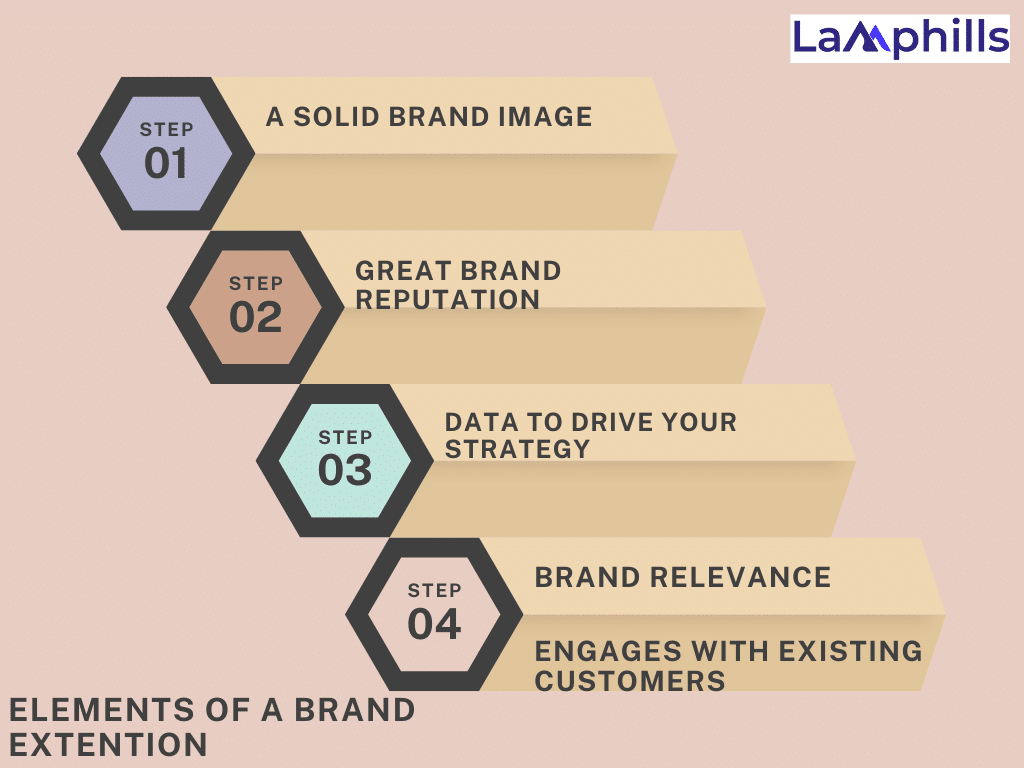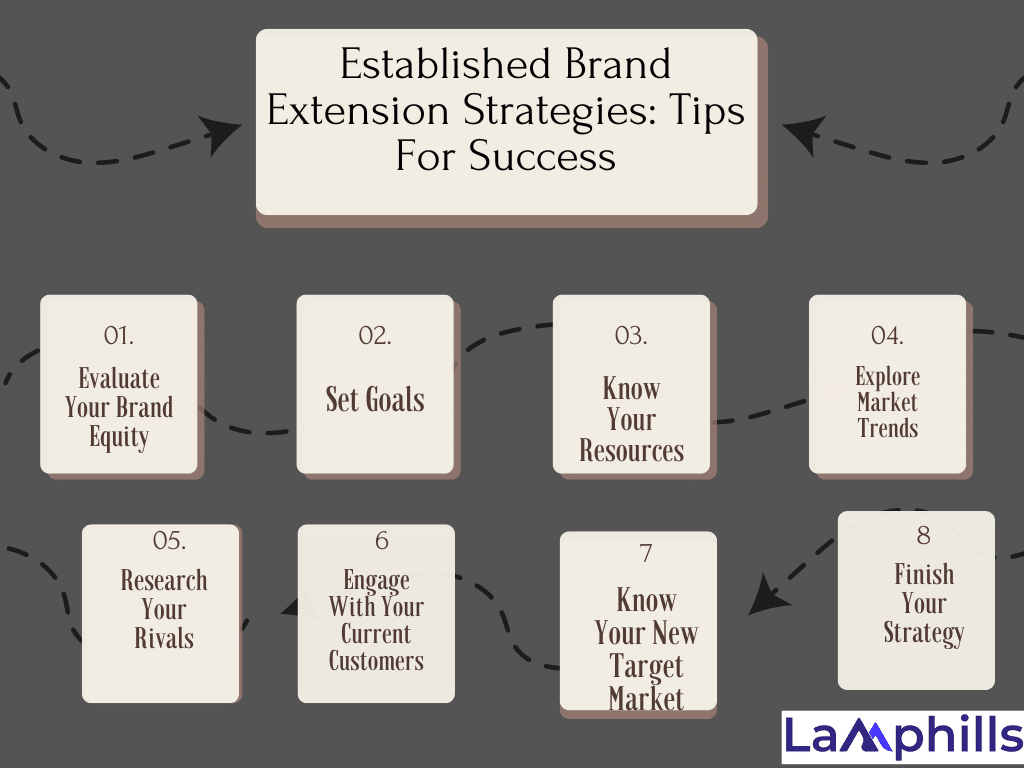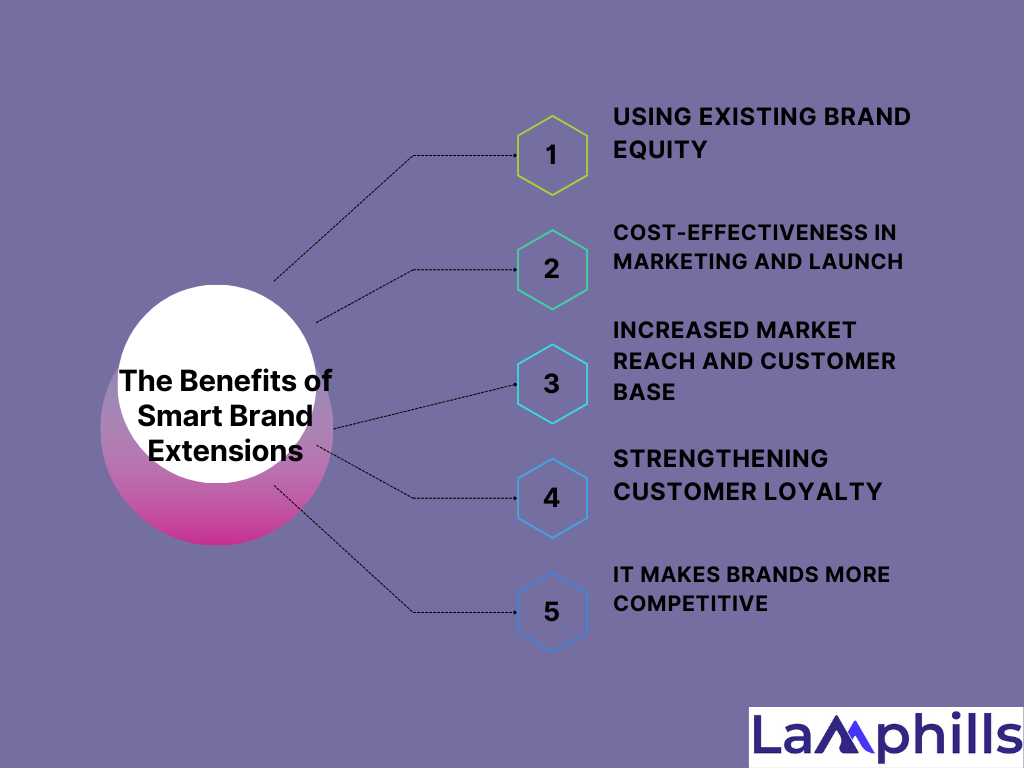When I started my journey in content writing, I had the privilege of working with several brands, exploring ways to expand their product lines. It was during these projects that I saw firsthand how smart brand extensions could transform a business, boosting customer engagement and unlocking entirely new markets. In this article, I want to share insights I’ve gathered from these experiences. I’ll dive into what brand extensions are, how they can fuel growth, and—more importantly—what you need to know to do it right.
Key Takeaways
- Smart brand extensions capitalize on the trust and recognition already built, offering new products that align with the existing brand’s reputation and values, ensuring customer loyalty and engagement.
- For success, the new product must resonate with the original brand identity. Misaligned extensions can confuse customers and damage the brand, as seen in the sports equipment brand’s failed food venture.
- A successful extension must offer something new and valuable to the market. Standing out through innovation, such as eco-friendly packaging or unique product features, drives customer interest.
- Brand extensions come with risks, including brand dilution and customer confusion. A phased, cautious approach can mitigate these risks, ensuring sustainable growth without overstretching the brand.
What is a Brand Extension?

Brand extension – sometimes called “brand stretching”—is when a business uses one of its existing names for a new product line or type. This growth helps a brand to stretch out in new directions but carries over the brand’s existing brand equity to instill customer trust and continue building on current brand loyalty. It can be a great way to reach new audiences, find new customers, and increase sales when done right.
However, it’s more than taking an established brand name and attaching it to a new product. There are multiple types of brand extensions within the architecture, and just using the same core brand name doesn’t automatically mean that a new offering will be a success.
Brand extensions allow you to take advantage of the trust and recognition you’ve previously established to provide something new. It’s similar to when your favorite restaurant starts offering catering services. You are confident in the quality because the restaurant’s food is already popular.
Not all brand expansions are made equal. Some prosper, while others struggle. I’ve seen firms fall victim to the myth that a strong brand assures success in any product category. That’s a risky assumption, which leads us to the crucial point: strategic brand extensions.
Considerations For Successful Brand Extensions

Now, let’s get into what separates a successful brand extension from a failed one. There are a few critical things to keep in mind.
#1. Alignment with Core Brand Values
First, make sure the extension is consistent with your brand’s basic principles. I remember a sports equipment company that expanded into the food market with an energy drink. It seemed out of place and eventually puzzled their consumers. A wise brand extension should be consistent with your existing brand identity. If your customers appreciate your brand’s commitment to sustainability, any new product should reflect that.
#2: Market Research And Consumer Demand
I can’t say it enough: research is everything. Before launching any extension, ensure that you understand your market and your customers’ requirements. I previously worked with a tech company that was eager to extend into the smart home industry. However, they didn’t properly research the demand for their product and launched without testing the waters. It resulted in a warm reception.
#3. Innovation And Differentiation
It’s not enough to just slap your brand on a new product. You need to offer something new to the table. A brand extension should provide buyers with a compelling incentive to buy that they cannot find somewhere else.
#4. Managing Risk
Finally, keep in mind that tremendous gain comes with a high risk. Brand expansions that stray too far from the original product risk diluting the brand or failing to achieve traction. I always propose a phased approach—start small, evaluate client interest, and then grow from there. That is how you mitigate the risk of overextension.
Examples of Good Brand Extensions
Let’s take a look at some inspiring examples:
#1. Michelin
When you hear the name Michelin, do you think of high-end restaurants or cuisine? Maybe both. Michelin created their empire by making vehicle tires. In the late 1800s, the automobile industry was still in its infancy, with less than 3,000 cars in France – the Michelin company’s home base.
Michelin released a guide covering petrol stations, maps, how to change a tire, and other important information to assist drivers in planning their travels and increasing car sales. However, the Michelin Guide did not become popular until the 1920s. As the guide’s popularity rose, mystery diners were dispatched to various restaurants to provide feedback, and a star grading system was added. Now the Michelin Guide is a must-have reference for foodies and tourists, covering restaurants in roughly 41 countries.
#2. Food Network’s Kitchen Items
With an audience of over 13 million people, Food Network remains one of the world’s biggest TV channels. Considering that many people were interested in what it does, Food Network saw an opportunity to extend its brand by partnering with Kohl’s Corporation to launch its kitchen and cookware products. The partnership was a success because Food Network served a specific audience with what they needed.
#3. Apple – Product And Category Extension
Steve Wozniak and Steve Jobs conceived and hand-built the Apple I computer, Apple’s first product, in 1976. The Apple I was a single-board computer that had all of the components required to build a functional computer, such as a CPU, memory, and display. It was offered as a kit, and customers were needed to provide their keyboard, display, and casing. Today, Apple still sells computers, but it also sells peripherals like keyboards and monitors, among other things.
But they didn’t stop there; their ability to create computers revolutionized the whole industry. They introduced the iPod, iPhone, Apple Watch, and HomePods. And considering how many people are fully supplied with Apple gadgets, we can state undoubtedly that this is one of the most successful brand extensions ever. Who knows what their next product will be?
Elements of A Brand Extention

A good brand expansion strategy includes a few aspects that transform it from a hazardous enterprise to a sure-fire success.
#1: A Solid Brand Image
Your brand image must be strong enough for people to buy into the new product or service you’re offering. A known brand image will make it easier for your audience to adopt new products because they are already familiar with the appearance and feel. They’ll prefer your new goods over non-branded alternatives since they recognize your brand’s look. Make sure your marketing plan focuses on what your clients already trust and enjoy about your brand.
#2. Great Brand Reputation
If you don’t have an established brand name, what motivation does a customer have to trust a new, potentially very different product from the same company? A technology corporation, such as Google or Samsung, can enter new areas because it has established a brand reputation for dependability and technical knowledge. This existing brand equity is critical to a successful brand extension. This is because a terrible product can rapidly erode or destroy your brand’s reputation, so be sure that whichever method you use to launch something fresh builds on your reputation.
#3. Data To Drive Your Strategy
A great brand extension will not occur immediately. You’ll need the correct insights to plan such a massive project. You may fix any new brand messaging before it goes live by getting all relevant information ahead of time on how your target segments will react and what perceptions they may have.
After you’ve launched the brand extension, you’ll want to track how your brand perceptions have evolved. Getting regular, consistent feedback will allow you to see how things change over time as you increase or decrease the resources you put into new brand activities.
#4. Brand Relevance
Brand relevance is pivotal for a successful brand extension strategy. Ensuring the new offering aligns with the brand’s core values and resonates with the target audience establishes a meaningful connection. This relevance reinforces customer loyalty and strengthens the overall impact of the brand extension.
#5. Engages With Existing Customers
Engaging existing customers is vital for a successful brand extension. You can integrate your new offering seamlessly into their lives by understanding their needs and passions. Prioritize planning and define goals, target markets, and key performance indicators. A well-thought-out strategy enhances customer engagement, fostering lasting loyalty.
Types Of Brand Extensions

There are several different types of brand extensions you can employ to expand your brand. They are explained below. Here’s a list of some of the top types of brand extensions:
#1. Product Extension
Product expansion occurs when a company introduces new products that are distinct from what they currently offer. The secondary item frequently complements the first, forming a companion product. For example, a coffee bean roaster may opt to offer creamer in addition to coffee beans.
#2. Line Extension
Businesses might offer a line or product form extension by providing more options for their current product. They may provide a slight variety by catering to a specific demographic or offering different size alternatives. For example, a toothpaste manufacturer may sell toothpaste for regular brushing and toothpaste for persons with sensitive teeth. A soda business may provide a 12-ounce bottle choice in addition to their standard two-lite option.
#3. Customer Franchise Extension
A customer franchise extension may arise when a company has a loyal customer base and can offer products outside of its existing product category that target the same group of consumers. This broadens the company’s product offerings while relying on the trust it has developed with this market group. For example, a soccer cleats store may expand into other sports products to target athletes and energetic people with whom it already has a reputation.
#4. Company’s Competence
Company expertise extension occurs when a corporation develops related product categories based on a certain talent it possesses. They can then leverage their skills and reputation in another product sector to reach a larger audience. For instance, a corporation may begin selling kitchen appliances and be popular for its innovative and visually appealing designs. They then may expand into offering home furniture with the same distinct style.
#5. Brand Distinction Extension
Brand differentiation extension occurs when a company has a distinct brand that is well-known for its benefits. Using this distinguishing feature, the company may expand into new niches and industries while maintaining the competitive advantages that first earned it prominence. A firm could accomplish this by providing items for certain groups, such as an organic hand soap company that provides special soaps for people who have dry hands.
Steps for Developing a Smart Brand Extension Strategy

So you’ve decided to go with a brand extension. Great! However, before you introduce your new product, there is some preliminary work to be done. Trust me; I’ve dealt with businesses that didn’t exactly think through their brand extensions, and the results can be painful—confused customers, low sales, and even brand damage. To help you avoid those mistakes, let’s break down the steps for a successful brand extension strategy.
#1. Do Market Research
If there is one thing I’ve learned from my years of dealing with firms, it’s that market research is essential. The excitement of launching something new might cloud your judgment, but taking the time to understand your market and audience can mean the difference between success and failure.
Market research is essential when deciding on a brand extension strategy. Surveys, interviews, and focus groups are useful for identifying opportunities and assessing compatibility in new markets. Analyzing collected data exposes consumer requirements and trends, which informs the formulation of a successful brand extension strategy. Failure frequently occurs when brands neglect market potential and client demands, emphasizing the significance of understanding customer acceptability and avoiding overextending brand associations.
#2. Conduct A Brand Audit
A brand audit is essential when adopting a brand extension strategy to reduce the danger of brand dilution. Assessing present brand value provides insight into its ability to endure possible consequences, ensuring a firm basis for the extension. Understanding key brand values enables effective leverage when presenting new items or initiatives.
#3. Create A Unique Brand Positioning
Create a distinct brand positioning for the new product by leveraging existing business and marketing knowledge. Use these characteristics to gain a competitive advantage in the new category. Identifying essential business competencies promotes efficiency and market distinction, hence increasing the brand’s overall attractiveness.
#4. Assess How Suited The Brand is To New Category in The Market
Determine the brand’s compatibility with the new market category. Ensure that the new product is logically consistent, harmonizes with the brand, and integrates effortlessly into the existing brand narrative. Establishing a readily traceable link between the new product and the parent brand is critical for avoiding frequent mistakes in brand extension.
#5: Determine The Potential Impact on Existing Items
Let’s be honest: when it comes to launching new products, some businesses become fascinated with the prospect of immediate profits. The truth is that long-term brand loyalty should always be the ultimate objective. If you focus entirely on short-term gains, your brand may suffer in the long run.
Consider the potential influence on existing products during a brand extension. Consistency is essential for success, as it makes the extension appear smooth and reinforces the identification of the brand’s distinct personality and values in the new offering.
What Are The Risks Of Brand Extension?

While brand extension can work well, it can also be risky. Some of the potential drawbacks that can stop a brand extension from working well include:
#1. Customer Confusion
Once, Colgate attempted to sell lasagna. Reading that text, or seeing that product in a grocery store, does not feel on-brand and may cause customer uncertainty.
#2. Quality And Consistency Concerns
When a company introduces a product that deviates from the line it has polished over the years, there may be some growing pains. Customers may lose trust in the brand as a result of their negative experiences with the new product.
#3. Diluted Brand Identity
Customers frequently link brands with their flagship products. When a firm introduces a new product that is not consistent with its prior offerings, the perception of what the brand represents might get clouded, weakening the brand identity.
#4. Product Cannibalization
Sometimes, the release of a new product as a part of a brand extension strategy can backfire if companies are not prepared for product cannibalization. When this happens, a company’s new product replaces an old product, leading to a dip in sales.
Established Brand Extension Strategies: Tips For Success

We now know what a successful brand extension strategy looks like, and what it can do for your business, but it’s important to understand how to properly plan and avoid any possible banana skins that can occur. Let’s look at the key steps that will help you implement a strategy other brands will be jealous of.
#1. Evaluate Your Brand Equity
Before you put pen to paper and begin preparing your strategy, you’ll need to assess whether your brand is strong enough to withstand any changes or additions. You’ll also need to determine what your strengths are, how you’ll protect them, and how they might be leveraged in your approach.
It’s tough to move forward without first ensuring the health of your brand, so look at factors like customer reviews and retention, as well as indicators like store/site traffic, search volume, and how much recent growth your company has seen.
#2. Set Goals
As previously said, a brand extension strategy can benefit your organization in more ways than just increasing revenue. Consider what you hope to achieve through your strategy. Do you want to broaden your reach? You want to fill a market gap. Are you addressing client demand? Or is it possible that you are attempting to create buzz around your brand or to subtly alter its image? Whatever your objectives are, make sure to set them because they will keep you on track and make it easier to design your strategy.
#3. Know Your Resources
How well prepared is your company to put your strategy into action? This is an extremely crucial question because a car cannot start without an engine. Do you have enough money to invest in your strategy? If less than intended, consider what changes you may make to keep your idea alive.
Do you have any investors helping to implement your strategy? If not, and funds are still limited, you could explore collaborating with another company to accomplish a brand expansion. Whatever you decide, be sure you understand your available resources so that you don’t overspend.
#4. Explore Market Trends
Take a look at what’s currently generating attention among customers. Trends will ebb and flow, but executing a market-relevant strategy will get you off to a solid start. Make sure you’re reading appropriate media publications and watching social media to find out what’s going on in the world of customers. Following and getting to know any industry influencers will help you stay relevant.
#5. Research Your Rivals
There may be a few rivals who appear to have everything under control. Do some research to see what works for them. This will give you an idea of what you need to succeed, and you may build on their already successful ideas by adding your touches.
#6. Engage With Your Current Customers
Existing consumers are the best resource for determining where you are winning and failing with your current items. The customer always knows best, and this is especially true when it comes to determining how to implement your brand expansion strategy. Engaging with your present consumer base will also provide you with insight into what the current market needs are, giving you a better sense of direction.
#7. Know Your New Target Market
Targeting a new market can be like swinging in the dark. If you don’t get to know your new target audience, you won’t know what piques their interest and, eventually, get those credit cards swiping. Spend some time investigating your new intended audience through social media, product reviews, forums, and any links you may have to influencers. This will also help to grow your brand awareness and put you on the radar of your new market.
You will want to learn about customer demand, current similar items, and your new competitors’ strengths and limitations. A few complementary goods for your new audience to try might also provide you with significant insights into customer demand.
#8. Finish Your Strategy
After you’ve gone through the list above, compile everything into a documented plan for your brand extension. Make sure you’ve thoroughly analyzed potential expenses and hazards, and if you have the resources and infrastructure in place to launch your brand extension. Refer back to all of your market and competitor research to ensure you’ve got everything in order and ready to go, and you’ll be on your way to success.
The Benefits of Smart Brand Extensions

There are several reasons why a brand extension is a pivotal part of business growth.
#1. Using Existing Brand Equity
Imagine being able to capitalize on the goodwill you’ve already established with your consumers. Smart brand extensions enable you to achieve exactly that. One of the most precious assets you have is your brand equity, which includes the trust, awareness, and loyalty you’ve built. When you release a new product under the same brand, customers are considerably more willing to try it.
#2. Cost-Effectiveness in Marketing And Launch
Launching a new product from scratch is costly. Brand awareness efforts, advertising, customer education, and other initiatives all incur expenditures. However, extending an existing brand reduces many of these expenditures because the buyer already understands what you stand for.
This was something I witnessed during my time with a beverage company. They had established themselves as leaders in the bottled water space. So, when they decided to branch into flavored sparkling water, they leveraged their existing customer base to spread the word, saving thousands in marketing costs that would have been required for a completely new product line.
#3. Increased Market Reach And Customer Base
Brand extensions allow you to reach new customer segments without alienating your core audience. By offering something new, you attract a broader range of consumers who may not have been interested in your original product.
#4. Strengthening Customer Loyalty
Another significant advantage of effective brand extensions is increased consumer loyalty. Consider this: if you love a brand and it begins to provide more things that correspond with your values, you are more inclined to continue with it. You’ll have more reasons to interact with them—and make more regular purchases.
I witnessed this with a small café that expanded its brand into packaged coffee beans. Customers who enjoyed their coffee shop experience might now take it home with them. This modest change strengthened loyalty because customers could now enjoy the brand at home before returning to the café for the full experience.
#5. It Makes Brands More Competitive
Not only will customers be more likely to buy from a brand they trust, 69% will continue to buy a product from a trusted brand even if a competitor is getting better reviews. Expanding what you offer to your customer base with a brand extension means that you’re able to make yourself more competitive, whether that’s in new categories or in your existing product line.
What is an example of a brand name extension?
Starbucks launched its range of coffee beans and coffee makers under the existing brand so consumers could enjoy the Starbucks experience at home.
What is another name for a brand extension?
This strategy, also known as brand stretching, matches the values of the existing company, or parent brand, to appeal to a similar customer base, while also generating new leads by entering a new market
What is the difference between a marketing line extension and a brand extension?
Overall, a brand extension involves expanding the company into new product categories where it’s less known. A line extension is when the brand creates a variation of an existing product to target new customer segments.
Conclusion
So there you have it: a guide to launching your brand extension strategy with optimum success. It’s a competitive market out there, but with proper planning and execution, our guidance will help you succeed. While a brand extension provides advantages, you should be aware that expanding your brand into uncharted territory will present new obstacles.
So, before you adopt any extension strategy for your organization, make sure it aligns with what your ideal consumer wants. benefit would a consumer derive from this new brand or product?
The businesses that take their time, do their research, and think long-term are the ones that succeed—and that’s exactly the mindset I encourage you to adopt as you embark on your brand extension journey.






